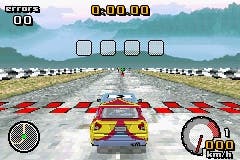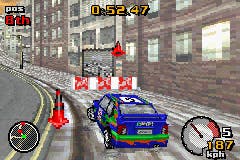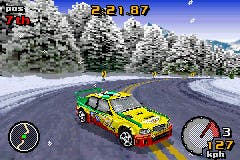Top Gear Rally
More like second gear...
Two and a half years into the GBA's life cycle and tens of million of units later (well over two million sold in the UK alone) Nintendo is still one of the only trustworthy sources of titles on the format. This year alone, the likes of Wario Ware, Advance Wars 2 and Zelda easily rank alongside our very favourite gaming experiences of the year on any format.
So what's the Big N doing licensing Top Gear Rally from Kemco rather than producing the next big racing title itself? It must be pretty damned good, or was signing it born from a necessity to pad out its range while the machine is flying off the shelves so impressively? Hopefully the former.
With a few positive mutterings emanating from various sources, we were intrigued to discover whether the diminutive format finally had a rally title to rank up there with Nintendo's other great handheld racing titles like F-Zero and Mario Kart; and since it's been over two years since anything majorly impressive arrived in the genre, such a title is long overdue.
Promises, promises

The signs were certainly promising - an immense 80 tracks to unlock over 10 distinct environments, three Championships leagues to progress through, a plethora of cars to unlock as well as tempting screenshots that (at the size of a postage stamp) gave the impression of graphics approaching the original Colin McRae, circa '98.
The game structure takes a pleasing arcade approach too, splitting up each 10-race championship series into three race mini-leagues, with each phase done and dusted in around two minutes each - prefect for those public transport gaming bursts we all love. Progress to the next mini-league requires a minimum of 11 points, and with three points awarded for third, four for second and five for first, you can afford to make the occasional slip up so long as you do better in the next race. Failing that, you can simply elect to restart at any time, with no penalty for doing so.
Unlockables are available for top place league finishes, with various extras granted, including new colours and eventually better cars. To start with there are just three rather inept cars to select from, each rated out of five in top speed, acceleration and suspension. Naturally this choice improves if you make progress, but that's a big if.
The slug and the sloth

Sadly it's all undone in a matter of seconds, thanks to developer Tantalus' inability to deliver anything approaching a true sense of speed and a sluggish handling model that means you spend more time working around the limitations of the hardware and the game design than enjoying racing a car around. Even when you're supposed to be roaring along at improbable speeds of over 130 mph, you'd swear you were going no more than 40 - such is the slothful pace with which the pixelated scenery gently wafts by.
The GBA has never been a capable machine when it comes to shifting 3D graphics at speed, and Top Gear Rally amply underscores the point. Whereas it's normally a given that Nintendo knows the limitations of its hardware and designs games carefully around it, Tantalus has bravely attempted the impossible and failed by being way too ambitious. Why Nintendo has bought into something that comes nowhere near its high standards is a mystery.
If you pretend it's 1993 and that exceptionally designed, lightning fast rally games haven't been invented yet, then it's feasible to have a reasonably good time with Top Gear Rally. In the context of handhelds and the limitations that brings, it's fair to say Tantalus has done a reasonable job of bringing the sport to the format. It's the kind of game you can bulldoze your way through bit by bit, gradually becoming more proficient as you go along and unlocking new tracks to hold your interest that bit longer. And with so many of them, and three difficulty levels to chip away at, there's arguably enough to keep you going for months - due in part to the frustration-free progression system that makes everything restartable and saves as you go along.
Squint a bit, blur your eyes

The graphics aren't bad either, with a pleasing amount of colourful variety across the staple snow/street/desert/forest environments. Sure, the pop-up is noticeable and the pixels are chunky (this isn't one to show off on your Game Boy Player) but there's so much being rendered at once it's no wonder it's making the GBA sweat. And with rolling hills, detailed streets, rain and snow all factored into the equation, is it any wonder the frame rate isn't that busy? No it's not, but that's no excuse for handling that makes you feel like you've got no real control over your car - it's just a case of being lucky enough to avoid the innumerable trackside obstacles and being able to remember the track layout or at least listen to the Gareth Keenan sound-alike barking out the pace notes.
And unlike real rally driving, TGR thinks it's ok to put other cars on the track to race against, rather than just rating your time against a field. As such, they're not really competitors in the true sense, but moving obstacles, and regularly become an even greater hindrance to posting a decent time than the proliferation of other trackside objects. It's a small point, but if you're going to make a rally game, at least follow the basic principles of rally driving, otherwise just make an arcade racing game.
When the core gameplay is so obviously hamstrung by fundamental design issues, there's no real incentive to get stuck into the meat of the game, and thus the chances of being able to enjoy the two-player link mode disappear into the ether. Throw in the requirement for two game paks for multiplayer and the fanciful £35 price tag and it's a catalogue of errors on Nintendo's part. Avoid.








